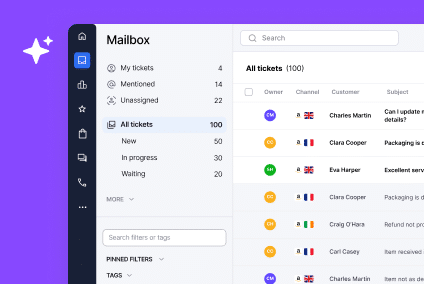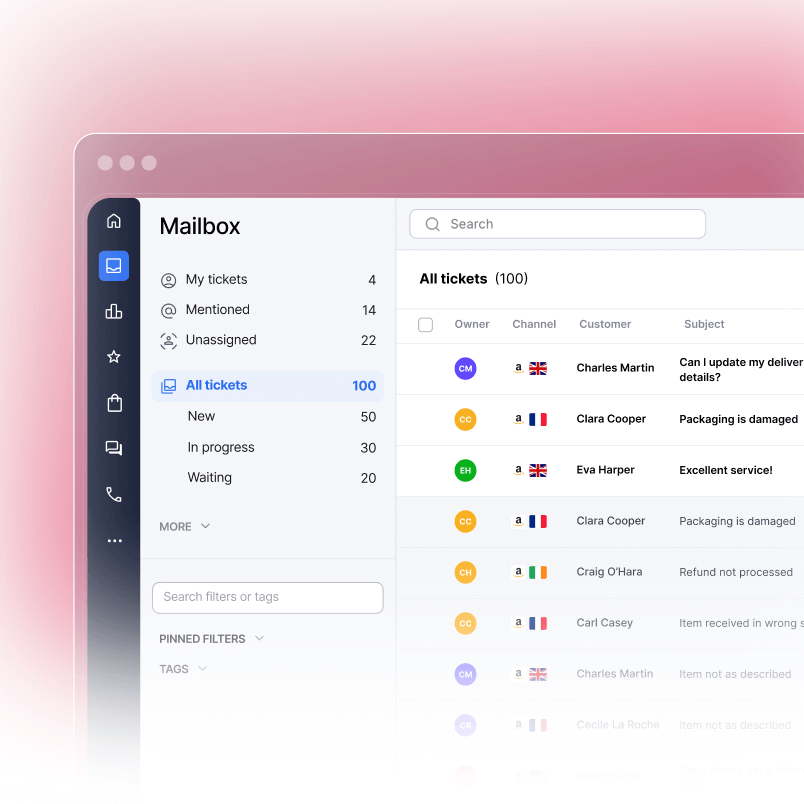Let’s be honest. Running an eCommerce business means dealing with repetitive customer service tasks day after day. Your team answers the same questions, handles the same order updates, and sends similar follow-up messages constantly. This takes time away from what actually drives growth.
The good news? You don’t have to handle everything manually. Many of these repetitive tasks are prime candidates for automation. When you automate the right processes, your team focuses on customers who need real human attention. Your response times improve. Your costs drop. And your customers stay happier.
We’ll walk you through 25 specific customer service tasks you can automate right now in your eCommerce business. Whether you use a platform like Shopify, BigCommerce, or manage orders through Amazon and eBay, these automation strategies apply across channels. By the end, you’ll have a practical list to implement immediately.
Order Confirmations and Shipping Updates
1. Automated Order Confirmation Emails
The moment a customer completes a purchase, send an instant order confirmation email automatically. This confirms their payment went through and gives them order details and a tracking reference. You don’t lift a finger. Your system sends it immediately while the customer is still thinking about their purchase. To get started with these automations across your sales channels, check out our comprehensive guide on ecommerce automation strategies.
Why does this matter? Research shows that 90% of customers say an immediate response is essential or very important when they have a customer service question, and 60% of customers define immediate as 10 minutes or less. Automation helps you meet these expectations effortlessly.
2. Shipping Status Notifications
When an order ships, send a notification automatically with the carrier name and tracking number. Update customers when packages are in transit, out for delivery, and delivered. Most shipping platforms integrate directly with your eCommerce system, so these go out without manual intervention.
3. Delivery Delay Alerts
If a package gets delayed, notify customers automatically instead of waiting for them to ask what happened. Proactive communication prevents frustration. Your system flags delays and sends the message for you.
4. Order Processing Status Updates
Between payment and shipment, send automatic updates. Tell customers when their order entered the warehouse, passed quality checks, or entered the packing stage. These touchpoints make customers feel informed without requiring your team to write a single message.
5. Re-engagement Emails for Pending Orders
If an order hasn’t shipped within your expected timeframe, trigger an automatic email to the customer explaining the delay and providing a revised ship date. This stops customers from contacting support unnecessarily.
Handling Payment-Related Inquiries
6. Payment Failure Notifications
When a payment fails, immediately notify the customer with clear next steps to resolve it. Include a direct link to update their payment method. Many customers don’t realize payment failed until they don’t receive their order.
7. Payment Confirmation Messaging
Send instant SMS or email confirming a successful payment. Include the amount charged, transaction ID, and expected delivery window. This acknowledgment reassures customers their purchase is real.
8. Refund Status Updates
Once you process a refund, automatically notify the customer when the money will arrive in their account. Include the refund reason, amount, and transaction reference. Transparency here prevents follow-up inquiries.
9. Duplicate Payment Detection
Your system can automatically flag duplicate charges and alert customers. Better yet, it can process refunds immediately without waiting for a customer to notice and complain.
10. Currency or Tax Clarification
If you sell internationally, automated responses can explain currency conversions, tax charges, or additional fees before checkout. Many customers abandon carts due to surprise charges at the end. Upfront clarity reduces this.
Responding to Frequently Asked Questions
11. Pre-Purchase FAQ Chatbots
Deploy a chatbot on your product pages to answer common questions before checkout. How long does shipping take? Do you offer returns? What’s your warranty? Customers get instant answers without your team fielding these questions later. Research shows that an AI chatbot for ecommerce can answer up to 80% of routine questions without human involvement. Our guide on choosing the best AI chatbot for ecommerce walks you through implementation strategies.
12. Post-Purchase Setup Instructions
Send automatic guides when customers purchase complex products. Include video links, written instructions, and troubleshooting tips. This reduces support tickets from customers stuck during setup.
13. Size and Fit Recommendations
For clothing and shoe sellers, use automated responses to guide customers on sizing. «Size up if between sizes.» «Check the measurement chart.» Personalize based on the specific product. Fewer returns and happier customers result.
14. Policy Clarifications
Automatically send your return policy, shipping policy, or warranty details when customers ask. These responses are templated and triggered by keywords like «return» or «warranty.»
15. Product Availability Notifications
When customers ask about out-of-stock items, automatically reply with your expected restock date or suggest similar alternatives. Let them sign up for notifications when inventory returns. This proactive approach is appreciated by customers. In fact, 87% of customers appreciate proactive solutions, and automation makes this achievable at scale without manual effort.
Managing Customer Feedback and Reviews
16. Post-Purchase Review Requests
Send automated review requests after delivery confirmation. Time it right (about 3-5 days after delivery) and you’ll get more responses. Include an easy link to leave feedback. Learn how AI-powered customer support for ecommerce can help you manage customer feedback at scale.
17. Negative Review Alerts
When a customer leaves a low-star review, automatically alert your team. Respond quickly and show other customers you take feedback seriously. Studies show this can often convert negative experiences into positive ones.
18. Review Response Templates
Generate automatic first responses to common review issues. You can then personalize based on the specific feedback. This keeps your review section active without manually crafting every reply.
19. Customer Satisfaction Surveys
After resolution of any support ticket, send an automated survey asking how satisfied the customer is. Use the responses to identify problem areas in your service.
20. Feedback-Triggered Alerts
If a customer leaves specific feedback like «shipping took too long,» automatically alert the shipping department. They see trends and can address systemic issues.
Handling Returns and Refunds
21. Return Authorization Automation
When a customer initiates a return, automatically send them a prepaid return label, instructions, and an RMA number. No manual intervention required.
22. Refund Reminders for Unreturned Items
If a customer starts the return process but never sends the item back, send automatic reminders at set intervals. Keep the process moving without your team chasing them down.
23. Restocking Notifications
Once a returned item arrives at your warehouse, automatically scan it and notify the customer that their refund is being processed. Update them when the refund posts to their account.
24. Defective Item Replacements
For defective products, automatically authorize replacements and send a prepaid return label in one message. Offer the customer a replacement or refund option upfront.
Escalating Complex Issues
25. Smart Ticket Routing
Your system evaluates incoming customer messages and automatically routes complex issues to the right team. A billing dispute goes to finance. A product defect goes to quality. A shipping issue goes to logistics. Customers get faster resolution because their issue reaches the right expert immediately. Automation tools that handle AI-powered ticket classification ensure nothing slips through the cracks and every customer gets the right support first time.
Why Automation Matters for Your eCommerce Business
Automating these 25 tasks does more than save time. According to recent industry data, businesses implementing comprehensive customer service automation achieve cost reductions of 60% on average while improving customer satisfaction by 200% within the first year.
Your team also works smarter. Instead of answering «When will my order ship?» for the hundredth time, they focus on genuinely upset customers or complex issues that need human judgment. Research shows that 76% of customer service representatives report that implementing chatbot automation has helped them significantly improve support efficiency. This job satisfaction also leads to lower turnover and better team morale. Learn how to write time-saving response templates that your team can use alongside automation tools.
Most importantly, automation scales your business without hiring more support staff. Handle twice the customer volume with the same team size. That directly improves your profit margins. According to Gartner, by 2025, 80% of customer service and support organizations will use generative AI to improve agent productivity and overall customer experience.
Real-world impact shows the power of these improvements. In one study, 92% of service teams that implemented automation reported their response times improved. Additionally, 65% of customers now expect faster response times than they did five years ago, making automation not just helpful but essential for staying competitive.
Start with the tasks that repeat most often in your support queue. If customers constantly ask the same question, automate the answer. If you send the same message 50 times daily, automate it. Pick three to five processes this week and implement automation. Measure the impact. Then expand from there.
The best eCommerce automation strategy isn’t perfect from day one. It evolves as you learn what your customers need most.
Final Thoughts
Customer service automation isn’t about replacing humans with robots. It’s about removing friction from predictable, repetitive work so your team can focus on building genuine customer relationships.
The 25 tasks outlined here cover order management, payments, FAQ responses, feedback, returns, and ticket routing. Implement them gradually. Start with whichever automation will save the most time or resolve the most common customer pain point for your business right now.
Ready to streamline your customer support? Explore how eDesk helps eCommerce sellers automate customer service across Amazon, eBay, Shopify, and more. Discover our time-saving tips for customer service automation or learn about advanced CX software to elevate your ecommerce success. For a deeper look at how automation works with growth, check out our guide on scaling up your support operations. Your team will thank you for the breathing room.
FAQs
What types of eCommerce tasks can I automate?
You can automate order confirmations, shipping updates, payment notifications, FAQ responses, review requests, return authorizations, refund processing, and ticket routing. Essentially, any task that follows a predictable pattern and doesn’t require human judgment is a good candidate.
Will automation hurt my customer relationships?
No. Automation handles routine, transactional interactions. Your team still manages customers with genuine problems or concerns. This actually improves relationships because customers get faster responses and your team has more time for meaningful conversations.
What’s the best automation platform for eCommerce?
The best platform depends on your sales channels. Shopify sellers have built-in automation tools. Amazon and eBay sellers often benefit from specialized software like eDesk. BigCommerce offers extensive automation. Many sellers use multiple platforms working together.
How long does it take to set up customer service automation?
Simple automations like email confirmations take hours to configure. More complex workflows with conditional routing take a few days to set up properly. Start small and expand over time rather than trying to automate everything at once.
Can I customize automated messages to feel personal?
Absolutely. Use customer names, order numbers, and purchase history in templates. Reference the specific product they bought or the issue they raised. Personalization makes automated messages feel human, not robotic.
How do I measure if automation is working?
Track response time, resolution time, customer satisfaction scores, and support ticket volume. Compare metrics before and after implementing automation. Most businesses see immediate improvements in response times and customer satisfaction.




